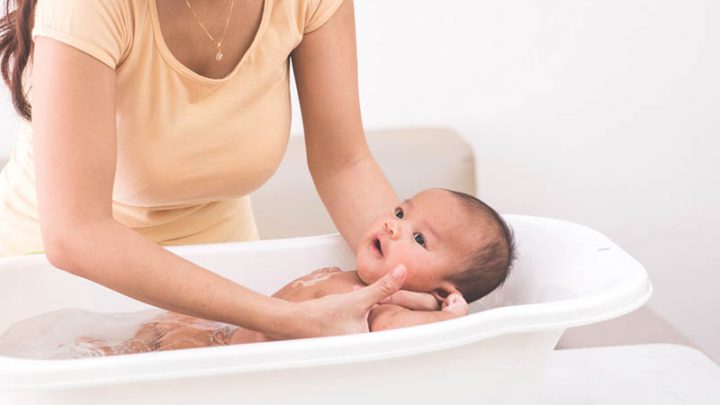Knowing how to bathe a baby is a skill first-time parents have to grasp, one that almost nobody gets right on the first try.
Many parents end up getting water in the baby’s ear which leads to a fussy little one, making parents wonder what they did wrong.
How to keep water out of baby’s ears during bath time is a common question.
The answer for how to keep water out of baby’s ears during baths has multiple solutions such as earplugs, Vaseline-covered cotton wool, or shower caps, but it’s also important to know how to bathe a baby the right way.
Why is it so important, you may ask. Because the so-called swimmer’s ear can be a real nuisance to kids when it does happen.
It’s by no means harmful on its own, however, it is as annoying as it is when it happens to you.
The real problem is the fact that it changes the pH balance in your ear and makes it easier to get ear infections, something you’d rather help your baby avoid.
So, if you want to prevent all of those nasty outer ear and middle ear infections that affect the eardrums, here’s what you need to do:
How To Keep Water Out Of Baby’s Ears During Bath
1. Earplugs
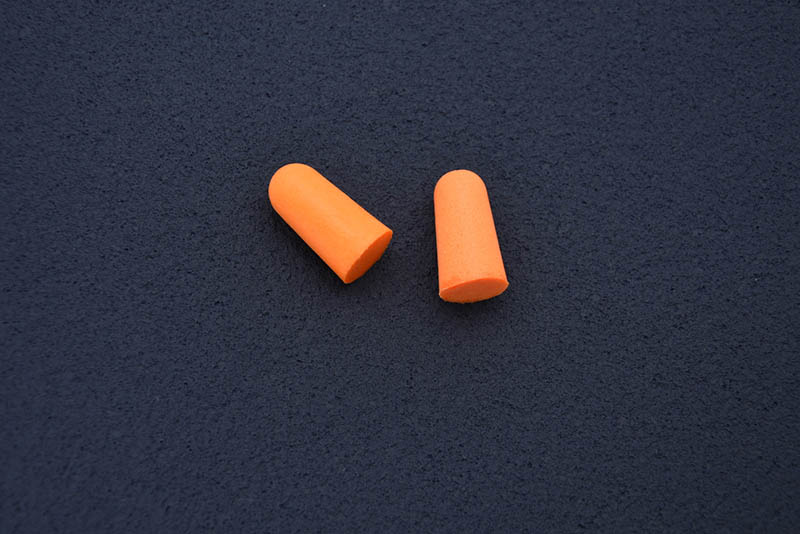
The first solution that comes to mind, and really the easiest one too, is earplugs.
Usually, the best recommendation would be moldable earplugs, although babies who are too fussy might end up giving you a little bit of trouble. They are, however, the best with regards to making a watertight seal.
There are other alternatives though, so you don’t have to worry too much if they don’t work. Just make sure that whichever ones you end up using are easy to clean and create a watertight seal.
It’s important to mention that even then there might be a chance that they fall out of place and break that seal.
This is because kids really like to fidget which may cause the earplugs to shift, in which case, some parents go for the extra precautionary measure of getting a headband, keeping the plugs in place during bath time.
2. Shower cap
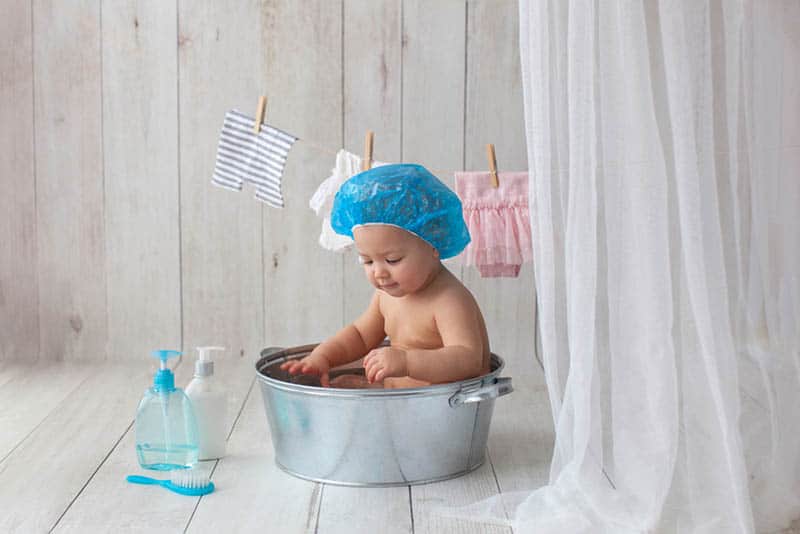
A different option that you might find interesting is a shower cap.
While not as effective as a set of earplugs given the fact that you’ll need to clean your little one’s head separately, it’s still a good answer to the question of how to keep water out of baby’s ears during bath time.
It’ll help you clean your little one without having to take too many special measures and then you can give his head a more thorough cleaning afterward.
3. Vaseline-coated cotton balls
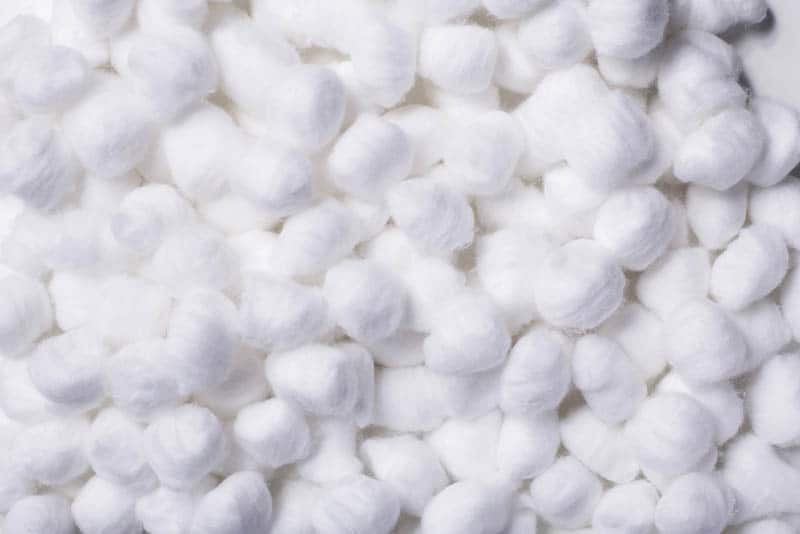
The final option that I’ve heard people frequently make use of is Aquaphor or Vaseline-coated cotton balls.
This is arguably the most accessible of the three, albeit a one-time use kind of deal as you’ll have to prep a new one each time.
It’s something widely recommended by doctors as well, all it takes is a few simple steps.
First, you want to grab half a cotton ball, depending on how big your child’s ear is, and a solid tablespoon’s worth of Vaseline. Rub all of it in until the cotton ball is thoroughly coated.
Make sure that there’s no spot left uncovered otherwise it’ll get soaked and prove to be more detrimental as it’ll just help the water get into the ear canals.
The second step is to take the Vaseline-coated ball and place it in the child’s outer ear. Be careful to not push it so deep that it ends up in the ear canals themselves as that might damage them – it should be just deep enough to keep the ball from falling out.
Finally, make sure to pat down the bits that are sticking out and tuck them in as best you can and you’ve just created your very own, DIY, moldable earplug.
That’s all there is to it, and while you’ll have to do it every single time, it doesn’t really take that long to do.
These are the three best-known solutions. In reality, you don’t really need to do baby baths so often as kids don’t get as dirty before they start developing a little bit of autonomy and crawling around the place.
You can try avoiding the ears during the bath without using any of the three aforementioned solutions, but that method doesn’t really work 100% of the time.
Water is really chaotic and if you don’t seal the ears up, you won’t be able to guarantee that it won’t get in so I’d suggest at least trying the cotton ball method.
Why Getting Bath Water In Your Child’s Ear Is Bad
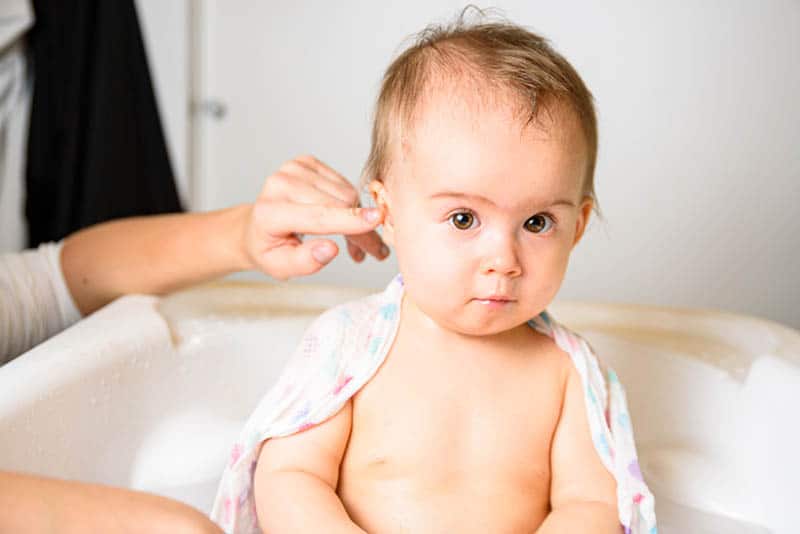
While it doesn’t seem that dangerous when it happens to us and it’s more the inconvenience of water sloshing around in your ear, in reality, swimmer’s ear is a real nuisance.
If it gets stuck in the ear canals, it’ll wear down the pH balance of the area and make it more likely for your kiddo to get an ear infection, paving the way for all sorts of fungus to take root inside which might lead to unnecessary complications.
There’s also the problem of your child having a lot less patience than you might have.
That odd feeling of having water stuck in his ear might lead to him throwing a tantrum and then you’ll have a very fussy baby on your hands.
On a side note, the chance of getting water stuck sloshing around inside your baby’s head, or rather, his ear, is far less likely with showers unless either you or the baby does something to increase the likelihood of that happening.
The main factor that dramatically increases these chances are the ‘tubes’ kids get put in their eardrums if they have frequent middle ear infections.
These tubes allow the fluid to drain from the ear, but also make it much easier for water and other fluids to make their way into the ear.
This, in turn, erodes that protective lining that exists in the ears and makes infections even more likely, a real double-edged sword.
Another risk factor in this whole process is the frequent use of cotton swabs, better known as Q-tips, to help remove earwax buildup.
It’s not as dangerous as the former, but the child’s ear is a lot more delicate than our own, and using a Q-tip on someone else is riskier because it’s difficult to judge the depth.
You become a lot less precise as you can’t feel where you’re going, making it more likely to accidentally go too hard and damage part of the outer ear or the eardrum itself making it easier for water to get inside.
Babies don’t really need a lot of ear cleaning when they’re young anyway, so leave the cotton swab use for later or, if you really feel it’s necessary, learn to be extra cautious when using them.
Accidently getting water into a baby’s ears isn’t the only mistake new parents tend to make when giving them a bath.
There are a few other ones that I’d like to point out so you can learn about them ahead of time and avoid them entirely.
10 Mistakes Parents Make During Baby Bath Time
Aside from learning how to keep water out of baby’s ears during bath time, there are a number of other things to keep in mind too, like:
1. Ignoring the value of quality time during bath sessions
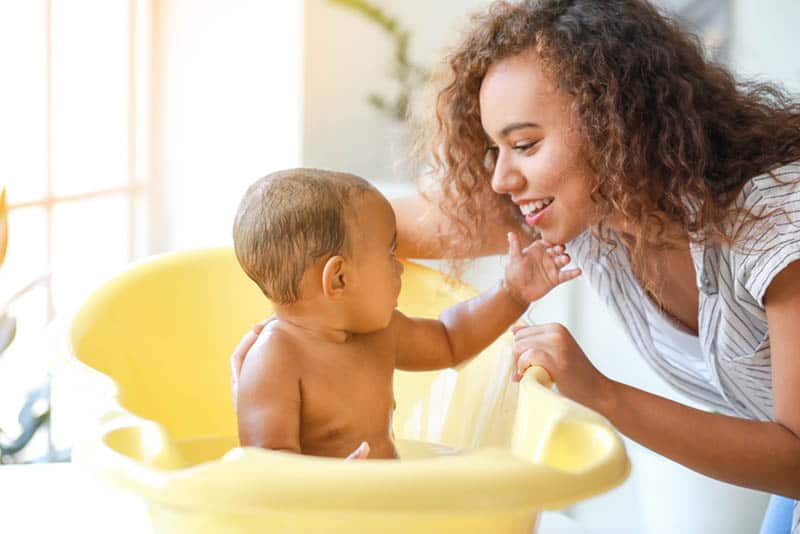
Given that the norm for maternity leave is a meager 12 weeks, moms who work full-time jobs don’t often get to spend time with their kids which can create a bit of a divide, but there are periods where you two are still alone.
One such example is the time you spend bathing your baby.
Sure it might not be the ideal movie vision of sitting in an armchair cradling your little one by the fireplace, but it’s still a rare opportunity to bond with your precious little bundle of joy.
Spend bath time talking to him.
Ask him about his day while you run the warm water down his body, poke his little hands with your finger to keep him busy and entertained while you apply baby shampoo to his lovely little tuft of hair.
Make the baby bath time experience one that’ll help you make up for the time that you spend at work, away from your baby, even if it’s just to gently caress your baby’s skin when giving him a sponge bath.
Don’t forget about baby-safe bath toys that will help your baby enjoy bath time even more!
2. Don’t spend too much or too little time in the bath
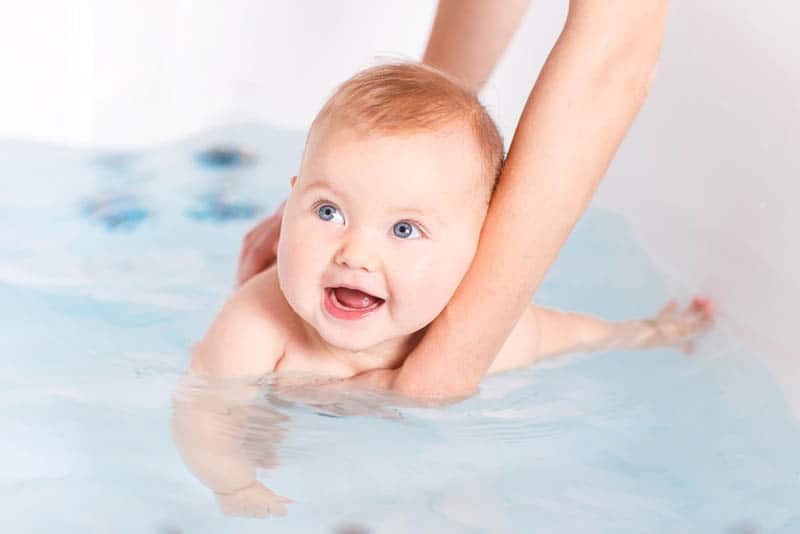
In many ways, this is linked to the previous point.
Many parents often think they should blitz through the time spent bathing their baby because they’ve been told kids shouldn’t be in the water for too long, but that doesn’t mean that it should last less than a minute.
Allow your kid some time to relax and interact with the water, it’s an experience that he doesn’t get often.
Let him splash it, fidget around with it and feel how the warm water feels on his skin folds.
I’d even highly suggest getting a toy or two to increase the variety of interactions that he can have in the tub to keep him interested for longer.
It’ll help the development of his motor skills a bit better than just having to lie down while you wash your baby’s face and clean his body with a wet washcloth or a soft towel.
After all, young children need all the stimulation they can get to help reach those baby leaps faster.
But, taking too long in the bath is also not recommended.
The max time a child should stay in a bath is 15 minutes, give or take a few, but, in reality, it’s however long it takes the water to become cold or for the child to start getting a bit too fidgety and uncomfortable.
Keep that in mind when you’re giving your kiddo a bath because you don’t want him catching a cold over a few minutes of extra playtime.
3. Getting shampoo in the baby’s eyes
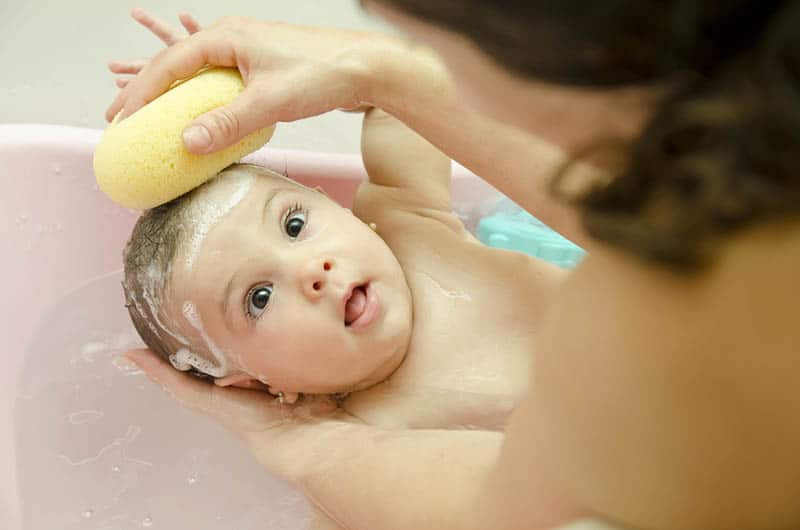
Giving your baby a bath takes a lot of dexterity from the parents as they have to learn how to properly clean every part of him while still securing the slippery little bugger to keep him safe.
It truly is a challenge, but the trick is to take it one step at a time.
For the sake of your baby’s wellness and overall satisfaction, don’t try to rush too much. Clean the easiest places first like the baby’s body and limbs.
The hair really is the trickiest part and should be left for last, especially if you’re using the shower cap that I mentioned earlier in the article.
Baby shampoo in your child’s eyes can be a real bother to deal with, even if it has a tear-free guarantee, it’s still a foreign substance and is likely to cause distress.
The key is to be very precise with the process.
I suggest leaning the baby’s head back before wetting his hair and applying only a smidge of shampoo directly onto the scalp and rubbing it in with a wet washcloth to prevent the spread from getting out of hand.
If you’re lucky, your baby will be still throughout the process and you’ll be able to just gently wash the shampoo off right after.
Otherwise, I’ve found that maintaining eye contact with your child and humming softly to him tends to work, but your child might have different soothing methods.
4. Not knowing how to dry the baby after a bath

It’s not just water in the ear that helps grow fungus, water in an innie belly button or other places can promote fungal growth too.
Not to mention that improper drying can cause a soggy diaper or a bassinet sheet right before bedtime.
This is why it’s important to know not just how to keep water out of baby’s ears during bath time, but also how to properly dry the baby without leaving any wet spots or irritating his sensitive skin too much by using the wrong drying tool.
When you take your baby out of the bath, make sure to get a soft towel to wrap him in nice and snug before you take him to a flat surface that’s nearby which most often ends up being the changing table.
Once there, make sure to clean the easy areas first like the back, the belly, and the hands before going for all the hard-to-reach places, drying them thoroughly and carefully which means going behind the ears, the armpits, the crotch, and the baby’s behind.
Make sure to also get between any skin folds that your baby might have as water is notorious for hiding away in there.
Once that’s done, dab the hair gently with a towel or use a low-power blow-dryer. Once the hair is dry, get the child fully dressed to retain the warm, comfy feeling the child has after a bath.
5. Don’t use too much water during a bath
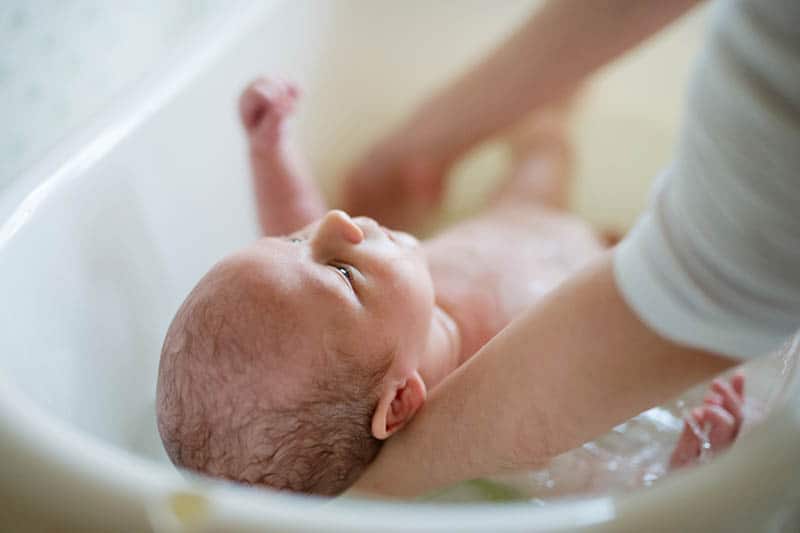
Many parents also fall into the trap of thinking that a baby’s bath should be similar to that of an adult and that there should be as much water in the baby bathtub as possible.
While this will keep the water warm for longer, it increases the risk of water going all over the place as well as the risk of your baby slipping in and swallowing the bath water, or worse.
That’s why so many people go with only a little bit of water in the tub while pouring warm water over the baby gently with either a soaked washcloth for infants or a cup/pitcher to keep the flow of water warm and steady.
The few inches of water in the tub will serve more as entertainment for the child than anything else and helps provide a bit of warmth.
To keep the child warm and content for a longer period of time, make sure that the room that you’re bathing him in is properly heated, that way you won’t have to resort to using more water to help keep him warm during bathing hours.
The same goes for the temperature of the water itself.
Make sure that it’s warmed up nicely and not scalding hot or freezing cold.
The former will feel very uncomfortable to downright painful for the child while the latter is likely to give him a cold and cause him great discomfort at the same time.
6. Don’t use adult shampoos and soaps on kids
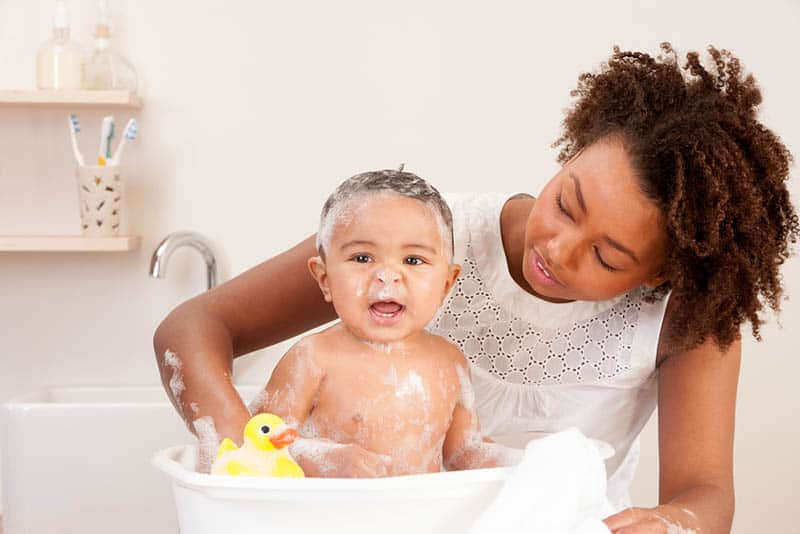
A child’s skin is a lot more sensitive than that of a grown adult.
When trying to save money, many new parents make the mistake of thinking that the shampoos they use for themselves will work for their kids too, but the truth is that they’re a bit too strong for the oils that the baby’s skin produces and it just tears right through it.
This ends up causing a lot of irritation for the child, especially if it gets into his eyes.
It’s something that you can’t really skimp out on as you need gentle, baby-safe soaps and shampoos to maintain your kid’s hygiene.
That said, even if you get baby-safe shampoos, giving your kids baths too often will have similar consequences which brings me to the next problem.
7. Babies don’t need to take too many baths
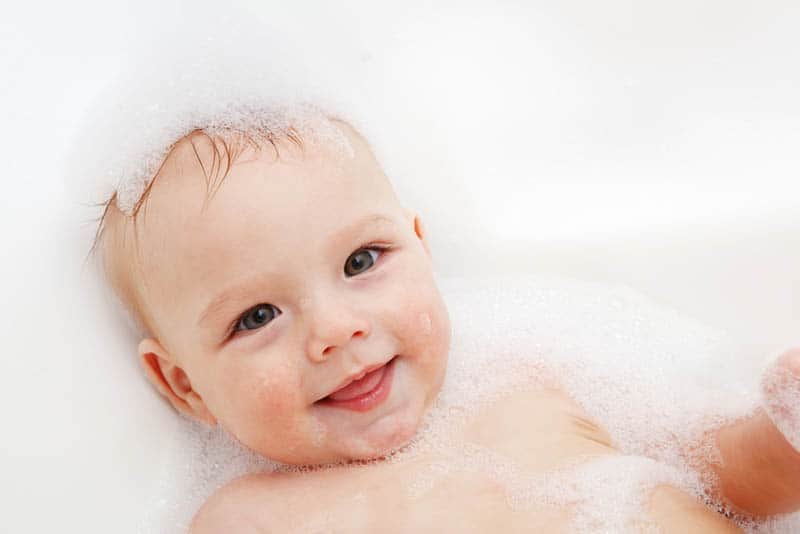
Many parents think that their kids need to have a bath every single day which couldn’t be further from the truth.
Most babies don’t really get very dirty until they start being more active and crawling around the home meaning they won’t really need to take more than maybe one or two baths a week tops.
In fact, while your baby still has his umbilical cord stump, you should only be giving him sponge baths as they’re a lot more precise than a full-on bath and are less likely to irritate the stump.
And, as far as diaper changes go, there’s a reason why we need so many baby wipes a year to keep our child’s butt clean.
If you clean the area adequately then you won’t need to consider a bath as that’s the only spot that really gets dirty.
Giving your child too many baths isn’t healthy because it’ll dry out the natural oils that their skin secretes, causing the skin to break and get irritated which, in turn, causes discomfort for the baby.
It can also lead to other problems like increasing the likelihood of eczema which is a whole other heap of problems that you don’t want to deal with.
8. Get a baby bathtub
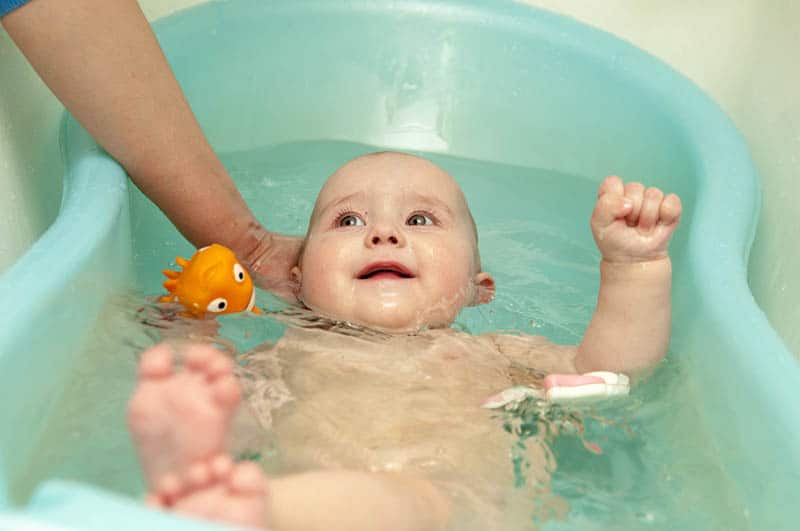
Another thing that might not come off as intuitive at first is the fact that the bathtub that you use for yourself might not be the best option for your child due to its size.
It wastes a lot more water than a smaller bathtub aimed for kids would and it makes it harder to keep the baby steady, especially if he’s all soaped up.
Giving your kiddo a bath is also infinitely harder in a larger tub due to the position you find yourself in which is usually kneeling down on the hard, tiled floor, bending over the side, and having to reach in way too far.
It’s honestly just a pain that’ll end up getting your clothes all soaked and soapy for no reason and it’s a position that allows for less control over the baby than a basic baby bathtub would.
They aren’t all that expensive either so getting one shouldn’t be a problem.
That said, you can still utilize the adult tub, but it works best if you get into the bath yourself which might promote a bit of extra bonding time.
RELATED: A Step-By-Step Guide On How To Bathe A Baby Properly
9. Don’t leave your kids unattended in a body of water
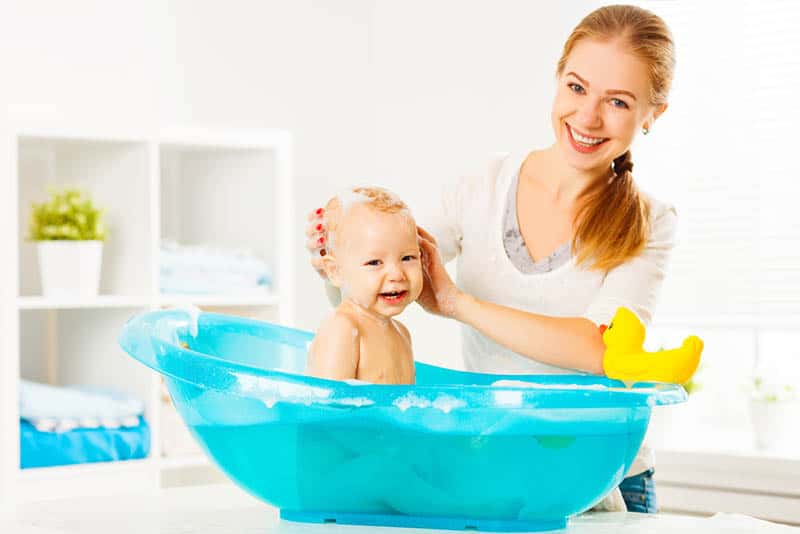
Regardless of tub size, you should never, under any circumstance, leave your child without adult supervision while he’s in a bath, even if it’s only filled up with a few inches of water.
Sure, many of these products flag themselves as “safe options”, but that safety only helps minimize the risks not completely eliminate them.
Kids can end up drowning even in two inches of water, that’s why, when you have to leave the bathroom for whatever reason, make sure to take your child with you.
Pause the bath if need be, it’s just a little bit of dirt, you can always start over.
Whatever the other emergency might be, it can wait until you get your child ready.
Baths can tip over from your kids fidgeting or the soapy suds might make them flip over face-first into the water and they might not be able to get themselves back up, so take those risks out of the equation and be there for your baby, give him your full attention.
10. Don’t drop the baby
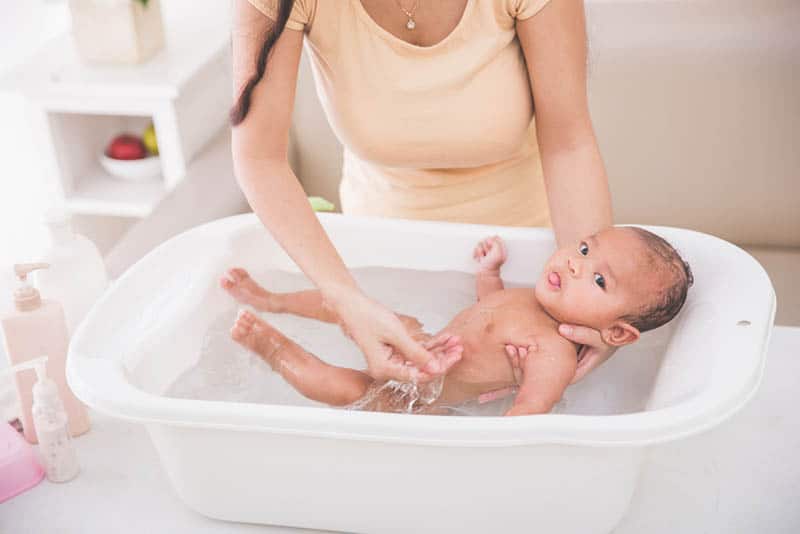
Even though this one goes without saying, it’s undoubtedly a real risk in the bathroom.
When handling the child in the bathroom, make sure to never lift him up without making sure that you have a firm grip on the situation, both figuratively and literally.
Babies can get really hard to handle, especially when lathered in soap or baby shampoo which increases the risk of him slipping out of your grasp when you try to move him which is why it’s important to wash off any and all soap on the baby’s skin before trying to move him.
This way you ensure his safety and minimize the chances of potential slip-ups.
To help make the odds even better, make sure that there’s another adult present too so you don’t have to do everything yourself.
Let them have a towel ready for when you’re ready to pull him out of the bath so they can safely cradle him and get a better grip on him.
While the idea of the supermom gets thrown around in commercials and media too often, trying to be one just ends up putting your child in needless danger.
There’s no shame in asking for help, remember that. And the plus side, bath time can become a beautiful family bonding experience!
The Bottom Line
As you can see, knowing how to keep water out of baby’s ears during bath time isn’t the only thing you need to know about giving your kiddo a proper bath.
There are many other things that you need to be aware of and mistakes that you should try to avoid.
While it might seem like a lot of information to take in, much of it is common sense.
Trust me, soon enough it’ll become second nature for you and you won’t even have to worry about all of these problems.
If you need more precise information don’t forget to consult your pediatrician on the matter of safety as well and for more accurate demonstrations.
They’ll be able to provide you with more trustworthy health information than I ever could convey with words alone.
Whatever the case may be, I’m sure you’ll be able to get a good grip on the situation, mamma.
Like this post? Please share or pin it for later. You can also stay in the loop and follow us on Facebook, Instagram or Pinterest.
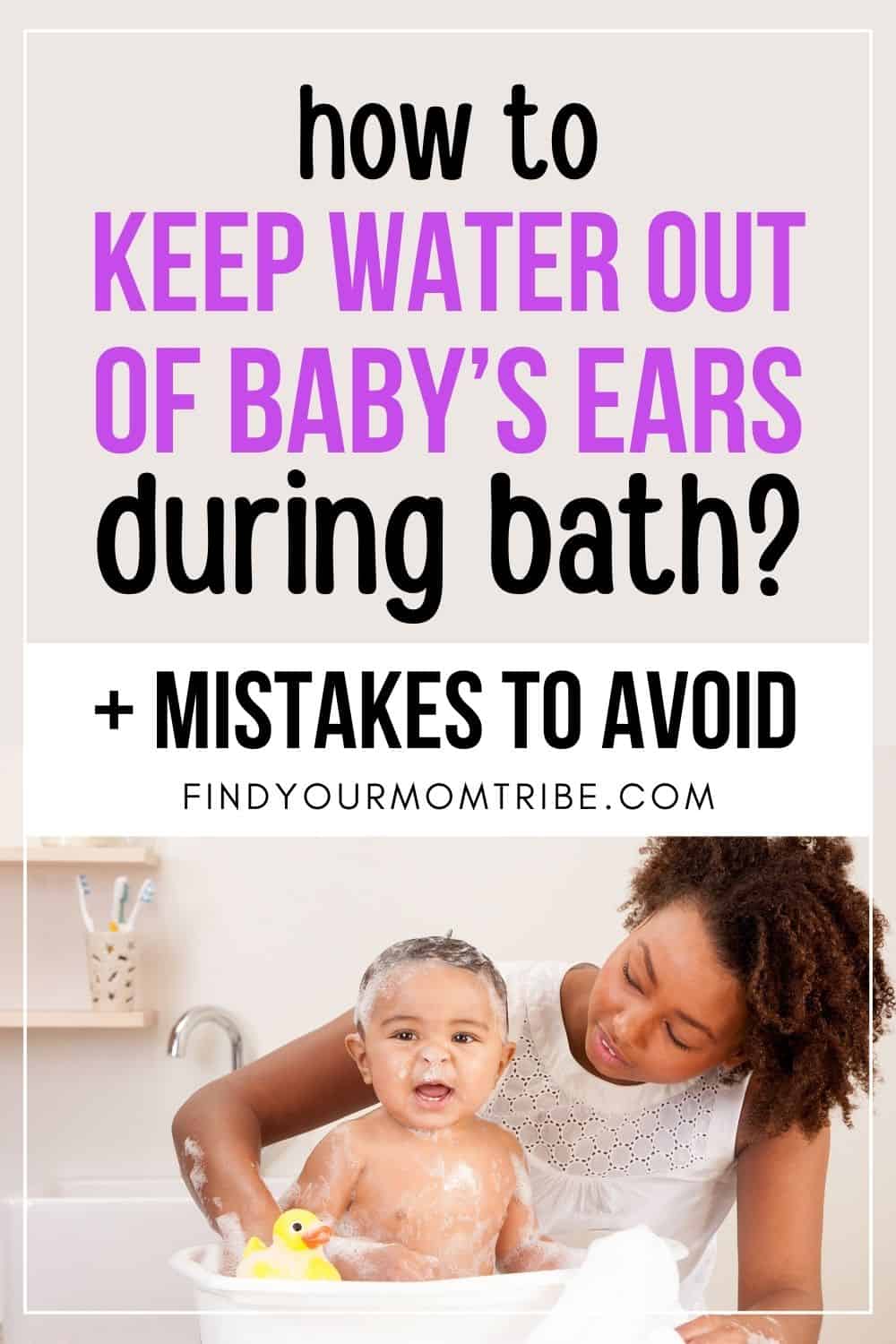
We love honesty! Find Your Mom Tribe is an Amazon Associate and we earn from qualifying purchases through affiliate links at no extra cost to you. Please see our full Amazon Affiliate disclosure for more information.

